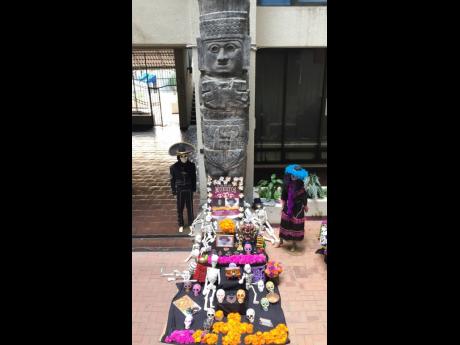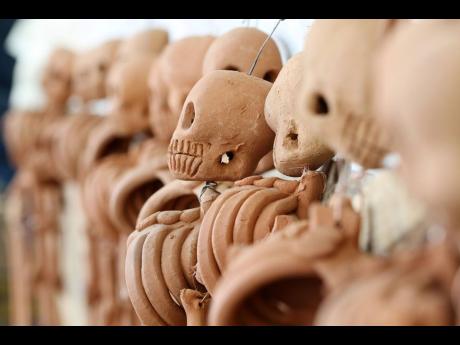Día de los Muertos: Divine connection with departed souls
Beyond the realms of popular culture, myths, fables, and perceived notions, customs, practices, and traditions that have their genesis in ancient civilisations, have deep rooted meanings, which personify and are key identifiers of a country or region’s belief system.
The mention of Day of the Dead flashes images, often, unfortunately associated with the unleashing of the evil, sinister plots, spirits wandering in the graveyards, with wolves howling in stereophonic decibels … eerie.
But, these images are far fetched from reality.
Mexico, where Día de los Muertos (Day of the Dead) is observed, is the celebration of death and the reuniting of the living with their dead. This celebration is one of the most representative cultural expressions of the country.
“It is a remembrance, a vehicle of communication and it is a very personal thing,” said Juan González Mijares, ambassador of Mexico to Jamaica, recounting the observance, adding that the day should not be taken on the face value of the images of people gathering in graveyards, decorating altars and holding candlelight vigils.
“It is day that we celebrate the homecoming of our loved ones who have passed on,” Ambassador Mijares said. “People have photos of their family members, friends, even their pets on a table in the house – among the offerings are their favourite dishes, salt, water, flowers and home made candles.
There are some key elements to the altar
- It typically has at least three levels.
- Photographs of the loved one to whom the altar is dedicated.
- Water – the source of life is offered to the souls to quench their thirst after their long journey and to strengthen their return.
- Salt – the element of purification, serves so that the body is not corrupted, on its round trip for the following year.
- Candles. The ancient Mexicans used ocote slits. At present, the candle is used in its different forms: candles, candles or waxes. The flame they produce means “light,” faith, hope. It is a guide, with its flickering flame so that the spirits can reach their old places and illuminate the return to their abode.
- Flowers. They are a symbol of the holiday for their colours and aromatic steles. They decorate and aromatise the place during the stay of the anima, which when leaving will leave happy, In many places in Mexico it is customary to put petal paths that serve to guide the deceased from the holy field to the offering and vice versa. The cempasuchil or Mexican marigold, is traditionally used to decorate the graves of the loved ones.
- Food – samples of dishes or meals that were enjoyed by the deceased during their life are added to the altar.
- Personal materials/memorabilia – Items that signify who the person was, their hobbies or passions are also added to the altar.
- Sugar skulls are allusion to death always present.
- Pan de muerto (Day of the dead bread): This light, bread has a slightly sweet taste and has crossbones baked across the top. It has a light citrus flavour.
“The whole atmosphere is that of solemn remembrance – it is a time to converse with your parents and loved ones – have a chat with them … and there is no better conversation than that of silence,” Ambassador Mijares said.
Syncretism
The origin of Day of Day is a result of syncretism between the celebration of the Catholic religious rituals brought by the Spaniards and the commemoration of the day of the dead that the natives performed since pre-Hispanic times; the ancient Mexicans, or Mexica, Mixtecas, Texcocanos, Zapotecs, Tlaxcaltecas, Totonacas and other native peoples of our country, transferred the veneration of their dead to the Christian calendar, which coincided with the end of the agricultural cycle of corn, the main food crop of the country.
This year is of particular significance as Mexico observes the 500th anniversary of the Spanish Conquest – the October 18, 1519 massacre of thousands of indigenous people at the ceremonial centre of Cholula, just east of Mexico City. The Cholula killings are perhaps the first large-scale indigenous massacre, the beginning of a series of mass killings in the Americas which continued up to the early 1900s.
Over time the day itself has manifested and given rise to diverse popular expressions, transmitted from generation to generation and to which, over time, they have added different meanings and evocations according to the indigenous people, community or group that carry them out, in the countryside or in the city.
In essence, Day of the Dead in the indigenous worldview implies the temporary return of the souls of the deceased, who return home, to the world of the living, to live with family members and to feed on the essence of the food offered on the altars placed in their honour.
Ambassador Mijares informed that the next day the family head to the grave sites of their loved ones, decorate the graves – deck them with the flowers, light candles, sing and pray. “We connect with our loved ones, welcoming them as they visit us,” he said.
The Day of the Dead, this year is being celebrated by the Embassy of Mexico and its altar is being dedicated to Francisco Lopez Toledo, Mexican painter, sculptor and graphic artist, whose career spanned seven decades. During this time, he became widely regarded as one of Mexico’s most prominent contemporary artists.
Cultural similarities
One is greeted with the sight of yellow flowers adorning the altars and resting places of the loved ones – cempasúchil (Mexican marigold) the traditional flower used to honour the dead.
“They (cempasúchil) bloom in autumn, are most evocative, the yellow colour is very dominant and is an integral part of the offering,” Ambassador Mijares said.
Interestingly, marigolds are an integral part of Indian tradition – the flowers are known as the “herbs of the Sun” symbolises creativity, passion, brightness, positivity and happiness – are an integral part of the offerings to the deities and in Hindu weddings.
Día de los Muertos also provides space for reproduction of different expressions – symbolic architecture, plastic works, handicrafts, ceremonial objects, and other items which personify and breathe life into the observance.
The celebrations are seeped in spiritual connections, unequivocal faith in the omnipresence of souls, which merely depart the mortal vehicles and move to other manifestations – a belief system that deep rooted in many cultures across the world.
The use of the symbolic skulls is prominently visible throughout – again not to be taken as some convoluted voodoo ritual – the skull signify death, and that is what is left behind of the departed souls.
“That is how the dead would look,” Ambassador Mijares said. “The skulls are made of sugar, and chocolate and the names of the loved one are inscribed on them.”
He though concurred that the festivities have evolved – especially after the 2015 James Bond film ‘Spectre’ where Bond chases a villain through a parade of people dressed up as skeletons in Mexico City, presumably celebrating Day of the Dead – before 007 began that quest to take on the villains – no such procession has ever taken place in the city before – but now it has become a staple of the city’s celebrations.
“The culture is alive, vibrant and evolving,” he said. Day of the Dead has been recognised as part of the Intangible Cultural Heritage List by UNESCO.
A Nahuatl (Nahuatl is a language of spoken by about 1.7 million Nahua people, most of whom live in central Mexico) describes Día de los Muertos thus.
A veces el colibrí, a veces el cuervo,
a veces el tecolote, nos dice cuándo hemos de irnos.
Pero nosotros los mexica no morimos,
sólo cambiamos de casa, de cuerpo.
Y cada año venimos aquí.
– Nahuatl poem
Sometimes the hummingbird, sometimes the raven,
Sometimes the owl tells us when to leave.
But we Mexicans don’t die,
We only change house, body.
And every year we come here.
– Nahuatl poem






